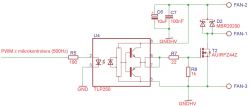Hello,
I plan to make a simple PWM system to control a 12V motor controlled from a microcontroller powered by 3.3V, hence the question about a logic level mosfet with the lowest possible RDS(on) resistance, with which I can control a motor with a load current of 10-15A? Will a heatsink be necessary at this current and low RDS(on) resistance? Any example of optoisolation for 3.3V? Thank you in advance...rob
I plan to make a simple PWM system to control a 12V motor controlled from a microcontroller powered by 3.3V, hence the question about a logic level mosfet with the lowest possible RDS(on) resistance, with which I can control a motor with a load current of 10-15A? Will a heatsink be necessary at this current and low RDS(on) resistance? Any example of optoisolation for 3.3V? Thank you in advance...rob



